
- Forum Listing
- Marketplace
- Advanced Search
- Manufacturer Forums

Tire clearance on a Domane
- Add to quote
Has anybody tried to fit a 650b on a domane? I have a steel bike that I run fat 650b wheels on and fast 700c. It's a pretty good way to get one bike to do it all. It seems like the domane is the road bike I want, but don't know if it'll fit 650b. Has anybody tried this or could measure their domane? The widest part of a 650b is at 32 cm from the axle or about 12.6" Thank you in advance!
It’s about 48mm on my 2017 SL6.
Ironic timing for this post. I saw someone post this question on the @TrekBikes twitter page today. They suggest 38mm max on the 2020 Domane, and not surprisingly, 650b is 'not recommended'. https://twitter.com/TrekBikes/status/1271557238029762563 The reason I say 'not surprisingly' is because some 700c bikes, especially in the large frame sizes, just don't take well to 650b wheels. It can do strangish things to the front end handling, and perhaps lead to pedal strikes if you have long'ish cranks.
Thanks, looks like it wasn't meant to be. Maybe I'll have to keep my libre and make it more road worthy.
I went through a similar search back in 2015/2016. I ended up with a Norco Search XR. It's a really good platform that would do well on road with road wheels, and on gravel with a gravel wheelset. I believe they come stock with 650b in all frame sizes, at least they did in 2017. I ride mine mostly with 700c wheels and 38mm Rene Herse tires. That covers about 99% of what I need. I did buy a set of Boyd Jocasse 650b wheels for it, and put 47mm WTB ByWays set up tubeless, but I guess I just don't have enough hard core gravel around (or I just don't ride on it), as I can never be fussed to swap them out. At this point the sealant is probably dried up in them and will need to be cleaned out before they can be used again. They'll probably go on flea bay once I clean them up. Edit: Just looked at Norco.com. IT looks like the current model year is spec'd with 650b for the 45.5cm and 48cm, and 700c for 53cm and up. I'm kinda surprised they have so many models in stock. They are usually pretty hard to get. They even have the steel version, which has been called a Unicorn Bike by some people. It's awesome, and comes with great kit. They rarely have them in in stock. If I was in the market for a steel all-rounder, I'd be all over this thing. My son in law has one, and he absolutely loves it. https://www.norco.com/bikes/2020/road/gravel/search-xr-steel/search-xr-s1/
I'll have to check it out. Besides my steel bike I have a kona libre, which is an amazing gravel bike, but on the road you can tell it's a gravel bike, so looking for more of an all arounder, and I'm convinced that 650x42 or 650x47 are better for me than 700x42. They handle better and accelerate better.
Have you checked out the Cervelo Aspero and their new all road bike? Sounds like they might fit your interests. The Salsa Warroad also might be exactly what you are looking for.
- ?
- 207.1K members
Top Contributors this Month
GIFT YOURSELF OUTSIDE+
Unwrap full access to digital content and more!
Powered by Outside
Review: Trek Domane SL Road Bike – Quick, Comfortable, & Easy to Recommend
It's easy to see why the domane all-road bike is so popular, even if it rubbed me the wrong way at times..

- Share on Facebook
- Share on Reddit
- Comfortable fit geometry
- Seriously smooth ride
- Surprisingly snappy handling
- Useful downtube storage
- Price is higher than most
- Not especially light
18.73 lb (actual)
There’s a decent likelihood that if you see someone riding a Trek road bike from the last decade or so, it was the brand’s Domane model. The ubiquity stems largely from its fit geometry, which has historically been very welcoming to riders of all abilities. Furthermore, the Domane’s unique IsoSpeed decoupling suspension system promised levels of comfort that other road bikes couldn’t quite match.
The IsoSpeed suspension system lives on in this latest Trek Domane SL road bike, but the rest of the package might be the biggest change we’ve seen with the Domane yet. There’s aero tube shaping, a lighter frame, and an added sense of performance that wasn’t quite there with previous Domane SL bikes.
We spent 1,000 miles on the Trek Domane to find out just how good the Domane is, whether that pursuit for speed has removed any form of comfort, and the potential downsides of living with a bike like the Trek Domane SL.
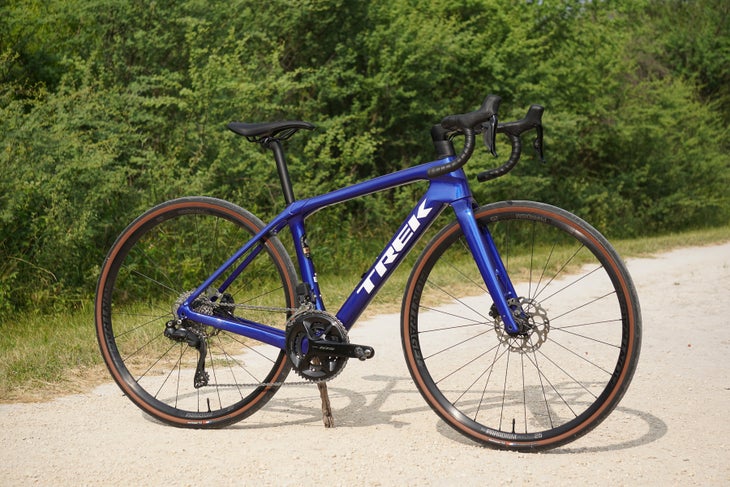
Quick hits: Seven things to know about the Trek Domane SL
- The Trek Domane lineup features three main framesets: the top-tier Domane SLR , the aluminum Domane AL , and this mid-range Domane SL carbon road bike. The Domane RSL is available as a frameset.
- Every Domane features fully internal cable routing through the headset, though the stem functions similarly to a traditional stem.
- The latest Domane SL and SLR bring a new internal storage compartment for a tube, tools, and an included neoprene storage sleeve.
- Max tire clearance is a quoted 700c x 38 mm.
- A new Domane SL frame weighs a quoted 1391 grams, 300 grams lighter than the previous Domane SL.
- Domane SL features a rear IsoSpeed decoupler to improve seated comfort, though it is no longer adjustable.
- Domane SL is available in seven sizes to fit riders between 4’11” to 6’5”.
Frame details
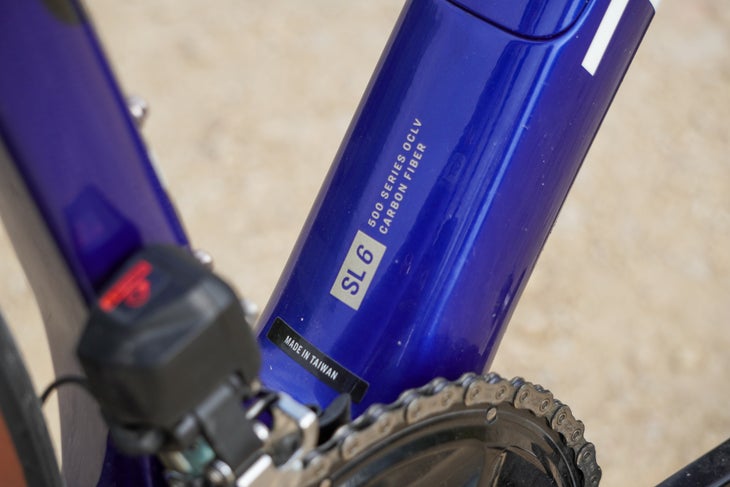
The Trek Domane is known for being an approachable road bike. Much of that comes down to handling geometry that values straight-line stability over race bike agility. Its fit geometry is more accommodating of a non-competitive cyclist than other bikes in its category.
The IsoSpeed seat tube flex system isolates riders from road vibration in a way few other bikes do. And while there are a number of changes to the latest Domane SL, most of those characteristics carry on.
IsoSpeed is a critical component of any recent Trek Domane road bike. Previous generations really went for it, offering not only adjustable rear IsoSpeed systems but even a front-end system to balance comfort between the two ends. This latest system essentially overhauls IsoSpeed, largely for the better.
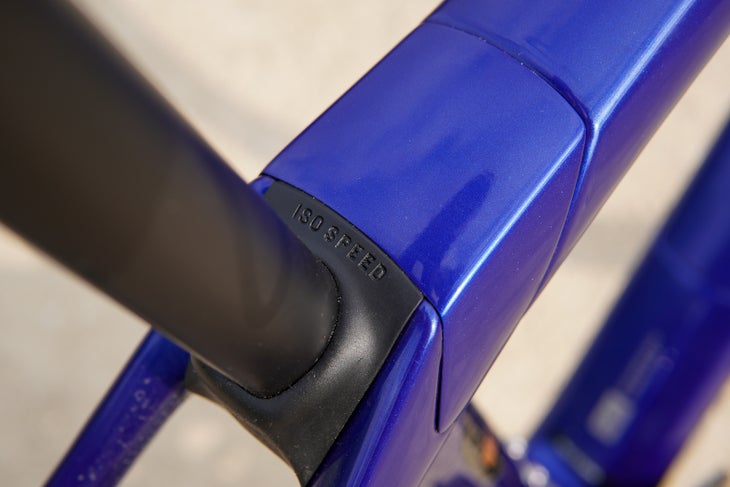
Most notable is that this latest iteration is said to offer as much flex as the softest setting in previous IsoSpeed systems while using a simpler D-shaped seat post. Previous Iterations of IsoSpeed used a carbon seat mast to offer the flex they wanted, but it was far more fiddly to use than this simpler system.
The front IsoSpeed system is gone, as the swap from 28 mm to 32 mm is said to be plenty comfortable. The fact that this system has far fewer moving parts and wear items should result in fewer creaks and durability issues compared to previous-generation systems. Trek says the system needs no servicing for the lifetime of the bicycle, and I never had issues with it in my time with the bike.
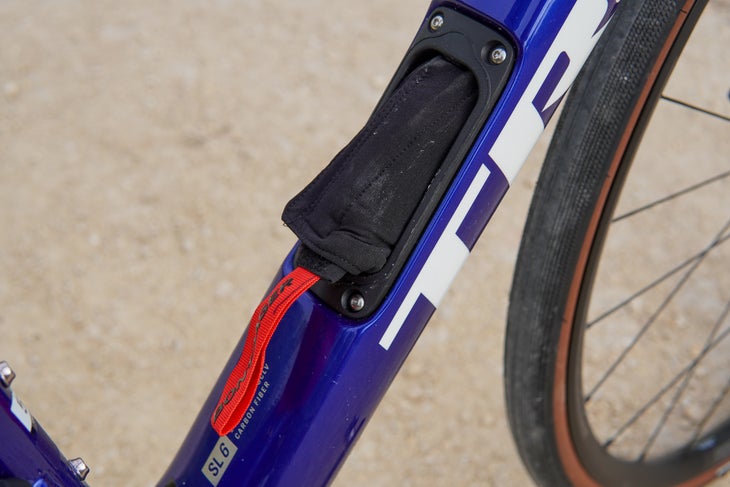
The Domane SL isn’t a particularly light bike. Some of that comes from the addition of a downtube storage hatch located under the bottle cage mount. Inside is a neoprene mini tool sleeve as well as plenty of space to add more snacks and perhaps a vest should you need to. It’s a genuinely useful storage area, with a sturdy latch and hatch system.
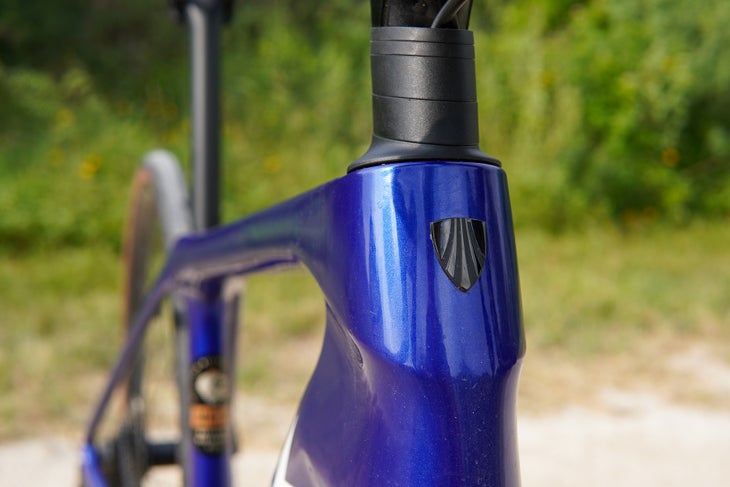
Trek’s Domane continues with internal cable routing, though this system is among the more refined systems I’ve seen and worked with. Cables are external at the bars until they’re routed under the stem, leaving some slack to play with stem height. And while the spacer profiling limits what types of stems you can swap with, doing the swap itself is an easy enough process that almost anyone can manage.
The internal routing system itself is one of the better setups I’ve seen. A guide at the inside of the downtube includes a holster for the Shimano Di2 battery, with guides for brake hoses and cable housing easily accessible from the downtube storage hatch. It’s easy to work on, all things considered.
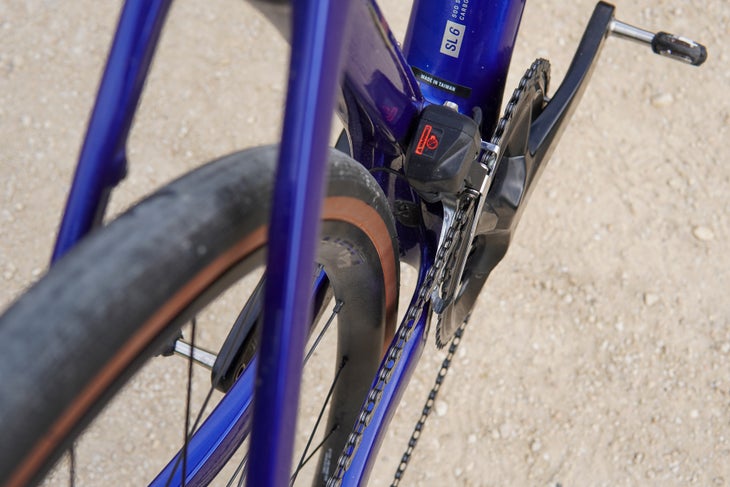
Tire clearance has always been a strong suit of the Domane, and that hasn’t changed. Max clearance is a quoted 700c x 38 mm tire. I was able to fit a 40 mm (42 mm width as measured) Pirelli Cinturato Gravel H tire front and rear without rubbing. That clearance makes light gravel and dirt road riding doable, but it would be problematic on a muddy or chunky ride.
Other bits of note include the use of a T47 threaded bottom bracket, the addition of top tube bag mounts, and hidden fender mounts. The frame gets its own integrated chain keeper, a nice touch that indicates the general user-friendliness of the bike.
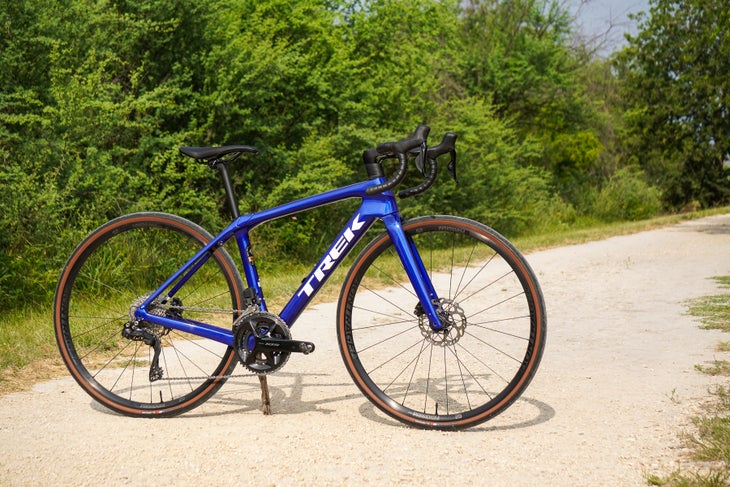
The build brought in for review was the Trek Domane SL 6 Gen 4. The highlight of the bike is the Shimano 105 Di2 drivetrain. The Bontrager Paradigm 25 wheels feature tubeless-ready alloy rims with a wide 25 mm internal width. The 32 mm Bontrager R3 Hard-Case tires, Bontrager Verse Short saddle, and Bontrager alloy handlebars complete the build.
A size 56 cm bike has a quoted weight of 8.62 kg (19 pounds. My 50 cm build weighed in at 8.5 kg (18.73 pounds) without pedals and accessories but with tubes in the tires.
The Domane has a reputation for being an upright road bike with handling that might be best described as stable. While the bike is stable, the geometry is far more agile than you’d expect.
Trail figures are around 59 to 61 cm across just about every size but the 44 cm bike. Handling geometry is quick enough for most people, though the low 75 to 80 mm bottom bracket drop and 420 mm chainstays add some straight-line stability back.
Fit geometry and rider positioning can be considered as upright, with a taller stack height and short reach dimensions. These numbers are taller and shorter respectively than even most all-road bikes, but I’d argue the numbers are realistic for most riders. Those looking for a more than 6 cm of saddle to bar drop (particularly on small sizes) will be better suited to something like their Emonda or Madone road bikes.
Standover heights across most sizes are about as low as I’ve seen on an endurance road bike, which is helpful for the height-challenged among us.
Riding the Trek Domane SL
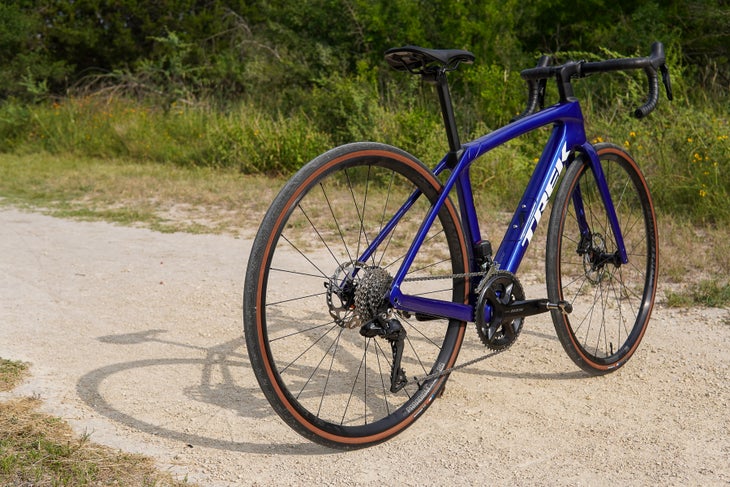
The value of the Domane doesn’t necessarily come from its cost or its tech-forward features, but rather in its promise of being a comfortable, approachable road bike. That isn’t lost here: the Domane is one of the most approachable road bikes you’ll find and an easy recommendation for anyone looking for a road bike.
The Domane rides as smoothly as it always has on smooth tarmac and chip-seal. The way the bike goes about smoothing out those small, constant vibrations is impressive. Roads I remember as feeling particularly jostling felt far smoother, both at the saddle and at the bars.
Much of that smoothness comes down to the 32 mm wide tires, which are wider than you’d find on most other all-road and endurance bikes out of the box. That said, narrower tires didn’t detract much from the bike’s smoothness over chip seal-type surfaces. Stay seated, and let the rear end of the bike do its job.
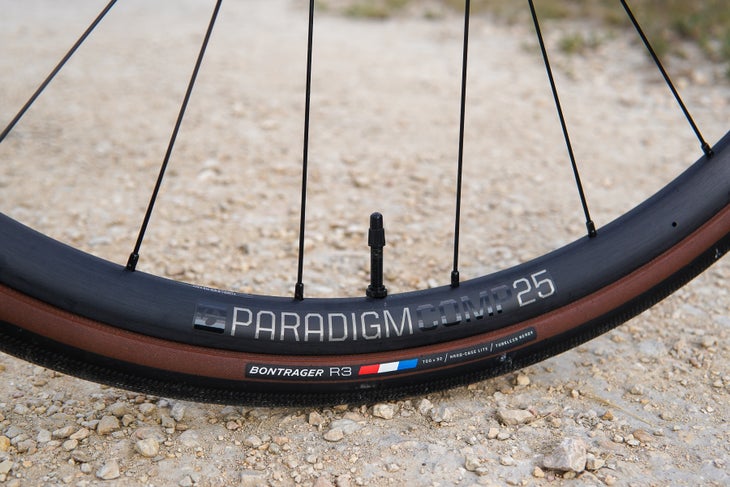
As much as I liked the Domane SL, the bike didn’t feel as eager as I would have hoped. Steeper climbs and even pedaling from a stop indicated that much of that came down to rotational weight. But with a set of carbon wheels and a good set of 30 mm tires, the Domane really woke up.
A set of Hunt Aerodynamicst 44 wheels and 30 mm Vittoria Corsa Pro Control tires gave the bike the feel of a bike far more willing to not only get up to speed but maintain it as well. If you’re itching to make an upgrade, rest assured that a decent set of carbon wheels – like their own Bontrager Aeolus Pro 37V – wake the bike up dramatically.
The stock Bontrager wheels are serviceable otherwise. They’re on the heavy side at over 1950 grams with tubeless tape and valves, but spoke tension and overall build felt like they were going to last. As serviceable as they are, however, it helps to know that you a swap to mid-range Hunt carbon wheels cut over 1 pound (520 grams) from the weight of the bike.
The Bontrager R3 Hard-Case Lite tires are grippy and seem to be long-lasting. That said, I felt the tires felt stiff and slow. A simple tire upgrade alone makes the bike feel considerably more eager.
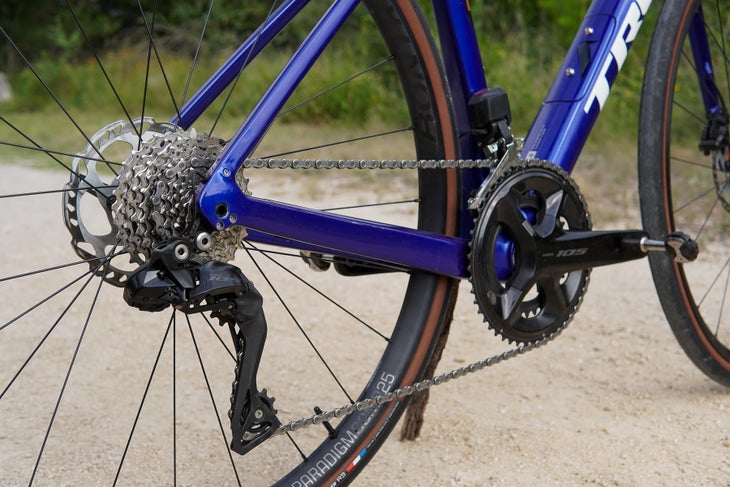
I found little fault in the rest of the build kit. Shimano 105 Di2 works phenomenally, with quick shifts and gearing plenty low for fondos. The Bontrager Verse Short saddle is wonderfully supportive for how soft the saddle feels. The Bontrager short-reach handlebar choice deserves some praise; its 38 cm width in a 50 cm frame is smaller than most product planners choose but the right size for smaller folks.
The Domane SL rubbed me the wrong way
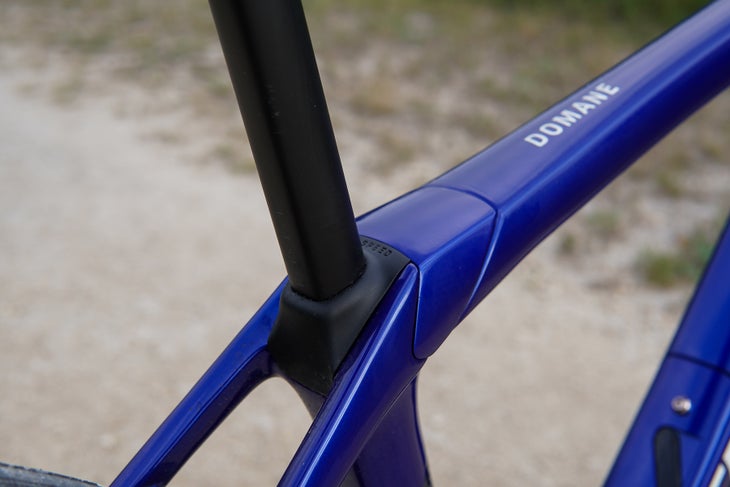
There was one notable fault I found with the bike, however: the IsoSpeed cover rubbed the inside of my legs on a 125 mile (200 km) road ride enough to create a rash.
A bit about me: I am fairly small at 5 foot, 6 inches and 130 pounds (59 kg) in kit. My legs aren’t particularly big, but they aren’t as lean as they could be either. I’ve received a professional fit and matched that fit onto the Domane SL to ensure my cleats (and feet) are roughly where they should be.
Here’s what the lead engineer of the Domane SL had to say:
“The Domane SL maintains the same thigh clearance as used on other road bikes. How far the max width carries up the seat tube can very slightly between models and this variation may be what you are experiencing compared to another Trek road bike. If it is an issue you could try going to a smaller size which moves his saddle up compared to the frame.”
The Domane SL top tube is wide, particularly as it approaches the seat tube junction. It’s wider at the seat tube junction than any other road bike I’ve ridden this year, though I don’t usually have problems with wide top tubes. The design weakness comes is the location of the IsoSpeed cover; the plastic cover seemed placed perfectly to rub the inside of my legs just above my knee raw.
Could I have sized down? Not really. I was on a 50 cm frame with the seat post extended to its minimum insertion point. Any smaller and I would need a drastically longer stem that would alter the handling Trek intended the Domane to have from the factory. Ultimately, some helicopter tape along the seam stopped the rub, but should I have to do that with a new frame?
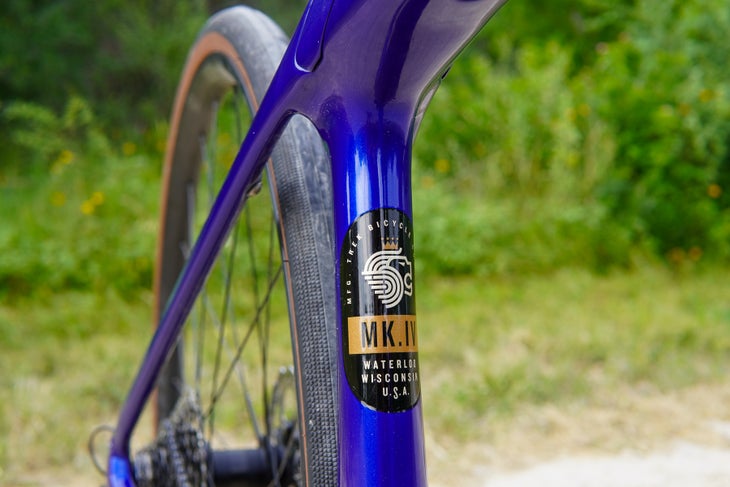
Like as with any other bike, give the Domane a test ride before you buy it, particularly if you’re smaller or have bigger thighs like I do. I suspect I am in a very, very small majority of folks to experience this. Considering how many Trek bike dealers there are in the world, it should be easy enough to take the bike for a spin.
The Trek Domane SL 6 vs the competition
Call it an endurance road bike or an all-road bike, this segment is one of the most competitive segments you’ll find. The three endurance road bikes I’ve ridden in recent memory are the BMC Roadmachine , Canyon Endurace , and Cannondale Synapse . The Domane offers the most upright fit geometry, but all are fairly comfortable to ride for the average cyclist.
Surprisingly, I found the Domane to have the quickest steering of the bunch. Despite that, it feels about as stable in a straight line as the other bikes. Add in the IsoSpeed system that seemed to smooth out chipseal as well if not better than the other bikes too as well as its internal frame storage and the Domane starts to stand out.
The Endurace edges the other three bikes out on value for money, offering Shimano Ultegra Di2 and nicer tires at a lower price point. However, I wouldn’t be surprised if you were able to find the Trek, BMC, or Cannondale on sale at a local bike shop, in which case you start to find good value for the money.
I would also take a close look at the Trek Domane AL , one of the most impressive bikes I’ve ridden in recent memory. It might lack the ultimate polish and ride smoothness of the carbon bikes, but the handling, rider fit, and wide 32 mm tires are still there. It’s a fantastic bike.
Choose the Domane SL if you’re looking for about as smooth a ride as you’ll find, want internal frame storage, and need the ultimate warranty support that comes from seemingly having a Trek dealer on every block.
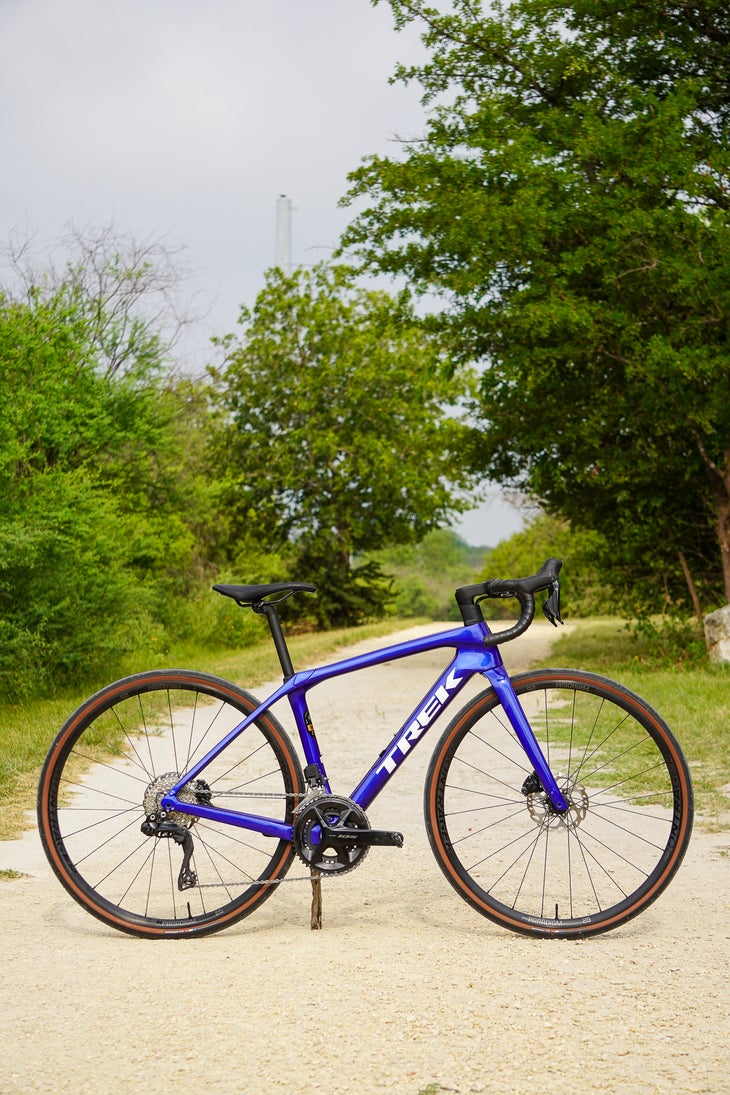
Long story short, I came away surprised by the bike. The latest generation Domane SL is every bit as smooth as you’d expect a Domane to be, and an approachable bike too. There’s a reason why it’s a go-to recommendation for most cyclists: the Domane reliably ticks every box for most road cyclists.
You pay for the privilege of riding the Domane, but considering how smooth the bike is over tarmac, I’m sure a vast majority of riders will be more than happy with it. The clearance for gravel bike tires, the internal frame storage, and the general refinement of the bike are all icing on what is a truly versatile all-road bike.
Just make sure you ride it so it doesn’t rub you the wrong way.
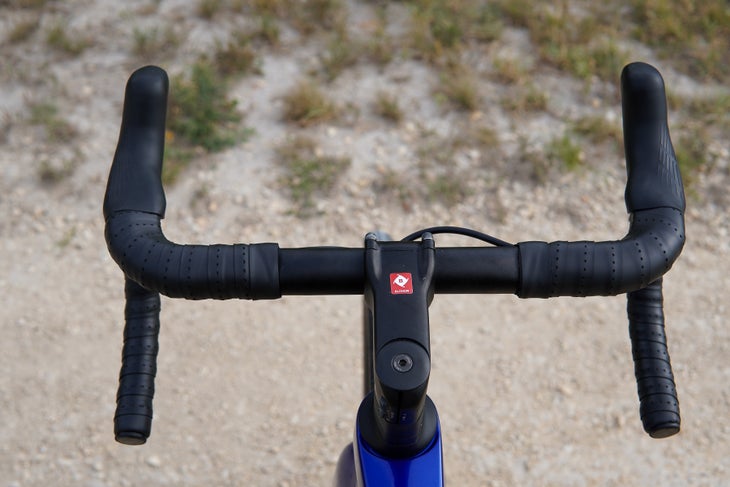

Popular on Velo
- RWR Home Page
- Recent Posts
- Bike Reviews
Trek Domane SL 6 Review: My New Favorite Gravel Bike
- by Riding With Ryan (Official)
Converting a road bike to a gravel bike is easier than you might think. In this Trek Domane SL 6 review we will cover what is both good and bad about the bike, as well as the modifications made to turn it into a gravel bike. If you have the AL version of the Domane pay attention. Converting the aluminum frame to gravel uses a different set of tire clearance specs.
As a road bike the Domane SL 6 would not rank well in many categories outside of comfort. As a gravel bike this thing is fast! Let’s dive into the details…
How Much Does Trek Domane SL 6 Weigh?
No road bike review would be complete without talking about weight. In this Trek Domane SL 6 review we will go over weight numbers and why they aren’t that important. There is no denying this is a “heavy” carbon road bike, but the well thought out features make it easier to ride farther and faster.
My Domane SL 6 is a size 56 cm. It weighs exactly what Trek said it would at 20.51lbs. With bottle cages, tire swaps and more I am running at closer to 22.5 lbs. A big reason this bike is over 20 lbs is because of the front and rear IsoSpeed.
The added weight of IsoSpeed may cost you a few watts, but what you gain in comfort more than makes up for it. Because this bike is so comfortable I can ride longer and faster on big rides. It also makes the bike perfect for those rougher gravel surfaces. You can run a narrower tire and maintain your comfort on gravel thanks to IsoSpeed. The reduced surface friction keeps me fast on the road too.
Trek Domane SL 6 Specs
The Trek Domane SL 6 is spec’d with a carbon fiber frame that includes both front and rear IsoSpeed. if you aren’t familiar with IsoSpeed it is essentially a coupler build into the from at the front headtube and where the seat tube connects to the top tube. The coupler absorbs some of the vibration before reaching your contact points making for a smoother more comfortable ride.
The wheels that come on this bike are Paradigm Comp 25. They aren’t the lightest wheels on a bike at this price point, but they are tubeless ready and work great with gravel tires.
The group set on this bike is the mechanical shifting version in Shimano Ultegra. The disc brakes are of course hydraulic, and I have to say I really prefer Shimano disc brakes over SRAM.
The saddle that comes with it is a Verse Comp, but saddles are something that should be custom fitted to each individual so I would recommend transferring your old saddle over or fitting for a new one.
The Elite IsoZone handlebars from Bontrager are nice. Because I did a gravel conversion, I switched over to ENVE bars that flare the drops out for a wider hand position during sketchy portions of trail.
Is the Domane SL 6 Worth It?
Even though I love this bike, I can’t say I will ever buy another one. For me, I want that high end electronic shifting on a race frameset, or I want something cheaper I can build up myself. Buying a carbon bike with mechanical Ultegra doesn’t get me excited anymore.
A big reason for my change of opinion could be the arrival of my Project One Trek Domane SLR 7 with Di2 Ultegra on it. Once you’ve ridden a bike with electronic shifting it is hard to go back to mechanical setups.
For many people the Domane SL 6 will already exceed their max budget. The 2021 SL 6 comes with a price tag of $4,099.99. One way I’ve been able to justify that high price tag is by using two different wheel sets. One wheelset has my gravel tires, the other my road tires. Now the bike works perfect to fill the needs of two different bikes.
How To Convert Trek Domane To Gravel Bike
There are a few steps required to make the change to a gravel bike. First, and most obvious, is a tire change. If you have the SL version of the Trek Domane you can fit a 38mm gravel tire, per trek. I personally use a 40mm gravel tire. I’m sure doing so would void my warranty if that tire were to cause damage, but I have over 1,000 miles without issues thus far.
For more information on gravel tires read: Which Gravel Tire Is Best?
Once you have your tires upgraded you will need to protect your bike. The new gravel tires will throw small gravel pieces are your frame. There is a product called Ride Wrap that makes precut vinyl for most bike models. Alternatively, you can pick something like this: 3M Clear Paint Protection Vinyl up on Amazon for $20 bucks.
Finally, converting a disc brake bike will be best. I really don’t like rim brakes covered in dust. When they get wet you lose stopping modulation, and your gravel riding experience will be a lot better on a disc brake bike. With the Domane being an endurance road bike the frame geometry is perfect for gravel biking.
If you have an old endurance road bike in the garage you already have the perfect bike to convert to gravel. If you want to really make a full conversion get some new handlebars that have drops flaring outward. This is a must have for a race gravel bike.
Can You Use Domane As A Touring Bike?
The short answer here is no. Even with the modifications made to turn it into a gravel bike, a touring bike requires racks for storage of supplies. Even as a gravel bike the Domane’s biggest downfall is a lack of storage add-ons available. Thankfully there is plenty of storage inside the downtube. There are also plenty of mounting locations for water bottles.
If this Trek Domane SL 6 review has you eager for a bike but you can’t find anything in stock visit a Trek dealer. One thing I love about Trek is the dealer locator on their website . For example, on the Trek Domane SL 6 page, you can see what dealers nearby have this exact bike in stock. Simply select color and size, then head to the closest dealer with the bike in stock.
If you don’t like drop bars and are looking for a bike at a much lower price point then the Trek FX 2 Disc may be the bike for you. Read my Trek FX 2 Review here.
2 thoughts on “Trek Domane SL 6 Review: My New Favorite Gravel Bike”
Hi Ryan, I’d like to know deeper insinghts about your sentence such as ” If you have the AL version of the Domane pay attention. Converting the aluminum frame to gravel uses a different set of tire clearance specs.” because I’m planning to buy a Domane AL for riding on/off roads as usual.
Thanks in advance. Best regards.
The aluminum frame and carbon frame have different tire clearance numbers. Double check with trek before committing to a size.
Leave a Reply Cancel reply
Your email address will not be published. Required fields are marked *
Save my name, email, and website in this browser for the next time I comment.
Privacy Overview
- Domane SL 6 Gen 3

IMAGES
VIDEO
COMMENTS
They suggest 38mm max on the 2020 Domane, and not surprisingly, 650b is 'not recommended'. https://twitter.com/TrekBikes/status/1271557238029762563. The reason I say 'not surprisingly' is because some 700c bikes, especially in the large frame sizes, just don't take well to 650b wheels.
Max tire clearance is a quoted 700c x 38 mm. A new Domane SL frame weighs a quoted 1391 grams, 300 grams lighter than the previous Domane SL. Domane SL features a rear IsoSpeed decoupler...
Questions have been asked regarding rear tire clearance for the 2023 Domane. I recently migrated my parts from a M/L 2021 ventum gs1 to a 56cm 2023 Domane SL. Here is a video of 40mm cinturato gravel H tires mounted to 2021 Zipp 303 firecrest (25mm ID) wheels spinning.
28c Bontrager tires (with at least 4mm of clearance to frame) Drivetrain.
In this Trek Domane SL 6 review we will cover what is both good and bad about the bike, as well as the modifications made to turn it into a gravel bike. If you have the AL version of the Domane pay attention. Converting the aluminum frame to gravel uses a different set of tire clearance specs.
Domane SL 6 is a performance road bike that's both fast and comfortable. It has all the road-smoothing advantages of an OCLV Carbon frame with Front and Rear IsoSpeed, a full Shimano Ultegra drivetrain, high-quality wheels, and hydraulic disc brakes for confidence and braking power in any conditions.